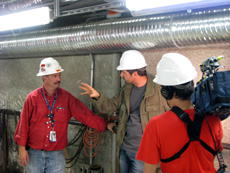Sometimes to find the biggest and best things, you have to dig deep -- 360 feet, to be precise.
A television crew for The History Channel wanted to learn about modern-day atom smashing underground, so they traveled to Fermilab to see the world's most intense neutrino accelerator beam. It takes a tunnel wider and taller, in some places, than a two-story home to house the beam, which helps physicists look for some of the smallest pieces of matter: neutrinos.
The television crew spent nearly two full days at Fermilab, which sits in the middle of a historic prairie in Illinois.
The resulting video clip, part of the Chicago episode of "Cities of the Underworld," is about five minutes long. It takes viewers into Fermilab's NuMI tunnel, where a beam of neutrinos is aimed at a detector in the adjacent tunnel as part of the MINOS experiment. A second MINOS detector sits 450 miles away in a mine in Soudan, Minnesota. The show offers vivid graphics describing how neutrinos and other particles interact along the underground journey.

The journey begins underground at Fermilab, where an intense beam of protons hits a target and produces a mix of other particles. By the time these particles reach the Fermilab MINOS detector, a quarter mile or so away, only muons--heavy cousins of the electron--and muon neutrinos remain. The muons get absorbed by the rock on the way to the second detector in Soudan mine, leaving only muon neutrinos for it to catch.
The underground game of catch helps physicists learn about the personality disorder of neutrinos: As they travel, neutrinos switch identities. On their journey from Fermilab to the Soudan mine, about a quarter of the muon neutrinos change into tau neutrinos, electron neutrinos, or perhaps an unknown type of particle that the MINOS detector doesn't register. Examining this transformation could help explain one of the mysteries of the early universe -- why matter came to dominate antimatter, allowing for the formation of planets, stars, and people.
The show schedule and information on purchasing individual episodes are here.







